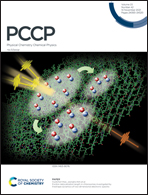Engineering ferromagnetism in Ni(OH)2 nanosheets using tunable uniaxial pressure in graphene oxide/reduced graphene oxide†
Abstract
The interlayer spaces in two dimensional (2D) layered materials such as graphene, metal oxides and metal chalcogenides can be used in a number of roles that include the trapping of gases, for ion transfer and for water purification applications. In such spaces, “inner” pressure occurs on guest species enclosed between the layers and its variation can, in principal, be used for precisely controlling particular guest properties. In this study, a mixture of two 2D materials including graphene oxide (GO) and nickel hydroxide (Ni(OH)2), was employed to yield an anisotropic GO–Ni(OH)2 hybrid 2D sheet. The inner pressure associated with this material was able to be tuned by reduction of the GO (to yield rGO) and this in turn was shown to affect the magnetic behaviour of Ni(OH)2. The ferromagnetic transition temperature (Tc) for Ni(OH)2 decreases as the interlayer distance became shorter, which is opposite to the behaviour observed for the application of hydrostatic pressure to the hybrid sheet. The uniaxial pressure affecting the interlayer of the 2D material, and generated by the reduction of GO to rGO, has the potential to not only influence the behaviour of a range of magnetic materials, but also individual properties of other types of functional materials.



 Please wait while we load your content...
Please wait while we load your content...